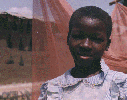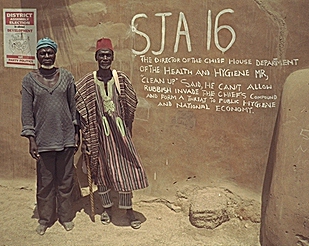


NHRC was set up in the late eighties by Dr. David Ross, an English epidemiologist (NHRC was then called Ghana VAST). The project took a census of over tens of thousands of individuals in the Kassenna-Nankani District. It was a massive undertaking as each compound had to be catalogued, marked, and gridded onto maps. The Centre was
originally set up to study the effects of Vitamin A supplemention on child mortality and morbidity. You get Vitamin A mainly through green leafy vegetables and it is important for maintaining good health. The problem in Navrongo is that compared to the recommended daily dose there is a low level of Vitamin A in the natural diet. You can even go blind (Xerophthalmia) if you have severe Vitamin A deficiency. The study found that approximately 60% of the children studied had moderate or severe Vitamin A deficiency. Two double-blind, randomized, placebo-controlled trials of large doses of Vitamin A administered at intervals of 4 months were conducted in adjacent populations in the Kassena-Nankani district. Vitamin A supplementation significantly reduced the overall incidence of severe illness, clinic attendances, hospital admissions, and mortality. Read the complete results from the September 1995 issue of the American Journal of Public Health. When the study concluded in 1992 the Centre and all of its resources were successfully handed over to the Ghanaian Ministry of Health. It's now headed up by Dr. Fred Binka. One of the first major efforts undertaken by the NHRC was to study the effects of bed-nets treated with a biodegradable insecticide called pyrethroid on the effects on child mortality. Bed-nets were used to prevent mosquito bites which is the mechanism through which people become infected with malaria. On April 4, 1996, the results of this study were released. "U.N. Says Mosquito Netting Could Save 500,000 Lives in Africa." "Antimalarial 'Bednets' Greatly Reduce Child Mortality in Africa, Studies Show." "The World Health Organization, an agency of the U.N., said that mosquito nets treated with insecticide to combat malaria could save thousands of lives of African children a year. According to results published in today's journal "Tropical Medicine and International Health", in trials of nets treated with a biodegradable insecticide called pyrethroid, malaria deaths in children under 5 were reduced one-third in Kenya, and one-sixth in Ghana."
The following photo was actually taken in Naga but it shows the demographic marking NHRC uses in its epidemiology trials. Beverly helped NHRC set-up a bed-net trial to see if bed-nets help reduce the number of cases of infant mortality from malaria.
The Population Council has sponsored several projects with NHRC. The following page describes one of these projects.
New York Times, 4 April, A13.
Washington Post, 4 April, A8.

If you want the whole enchillada then here's the full U.N. press release. You should also follow these links on bed-nets and children's health in Northern Ghana from the International Development Research Centre (IDRC). You can also learn about how NHRC is helping in its small part to reverse the "brain-drain." General information can be found at the HealthNet Navrongo WebPage.

This is the Naga chief (right) and a sooth-sayer. The writing under the number reads The Director of the Chief House, Department of the Health and Hygiene, "Mr. Clean Up" said, he can't allow rubbish (to) invade the chief's compound and form a threat to Public Hygiene and National Economy.
 Back to the Main Page
Back to the Main Page
 Back to Virtual Navrongo
Back to Virtual Navrongo

© MCMXCVIII All Rights Reserved